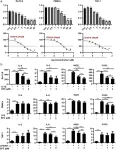Results of the trial, sponsored and funded by the National Institutes of Health’s National Institute of Allergy and Infectious Diseases, appear in the Monday, February 10 issue of NEJM Evidence [https://doi.org/10.1056/EVIDoa2400306].
“Our study results suggest a safe, inexpensive and effective pathway for allergists to treat children with peanut allergy who can already tolerate the equivalent of at least half a peanut, considered a high-threshold peanut allergy,” said Scott Sicherer, MD, Director of the Elliot and Roslyn Jaffe Food Allergy Institute at Mount Sinai Kravis Children’s Hospital, Chief of the Division of Allergy and Immunology in Mount Sinai’s Department of Pediatrics, and lead author of the paper. “Our findings open the gateway to personalized threshold-based treatments of food allergy and will encourage additional studies that delve deeper into peanut and other foods for this approach that might be a game-changer for the majority of people with food allergies.”
The most common approach to a food allergy is to avoid the food, but in recent years peanut oral immunotherapy—medically supervised, very gradual daily feeding of increasing amounts of pharmaceutical-grade peanut protein—has become an option for individuals with peanut allergies.. However, studies that led to Food and Drug Administration approval of an injected biologic and oral peanut immunotherapy have specifically focused on people who react to very small amounts of food allergens, such as half a peanut or less (considered a low-thershold peanut allergy). There are an estimated 800,000 children in the United States with high threshold peanut allergy who might benefit from the treatment strategy examined in this study.
“Years ago, when people with milk and egg allergies were advised to undertake strict avoidance, our team initiated studies that found most people with milk and egg allergies could tolerate these foods in baked goods, which changed the global approach to these allergies,” said Julie Wang, MD, Professor of Pediatrics at the Icahn School of Medicine, clinical researcher at the Jaffe Food Allergy Institute, and co-senior author of the paper. “The research team recognized that more than half of people with peanut allergy can tolerate half a peanut or more, and thought that this group of people might be treatable if we took a different approach to peanut oral immunotherapy. We were thrilled to find that this treatment strategy was even more successful than we had anticipated.”
To test this hypothesis, the study team recruited 73 children ages 4 to 14 years old. Study participants were assigned, at random, to either test the new treatment strategy or continue avoiding peanuts. The children in the peanut-ingestion group began with a minimum daily dose of 1/8 teaspoon of peanut butter and gradually increased their dose every eight weeks over the course of 18 months, ending at one tablespoon of peanut butter or an equivalent amount of a different peanut product. All dose increases took place under medical supervision. None of the study participants in the peanut-ingestion group had severe reactions or needed epinephrine during home dosing and only one received epinephrine during a supervised dosing visit.
Following the treatment regimen, children from the peanut-consuming cohort participated in a feeding test, carefully supervised by the study team, to evaluate how much peanut they could eat without an allergic reaction. All 32 children from the peanut-consuming group who participated in the feeding test could tolerate the maximum amount of nine grams of peanut protein, or three tablespoons of peanut butter. By contrast, only three of the 30 children from the avoidance group who underwent the feeding test after avoiding peanuts for the duration of the study could tolerate this amount.
Because the trial took place during the COVID-19 pandemic and some families preferred avoiding close encounters indoors, some did not return to the study site for the feeding test. Using a common statistical technique to account for the children who missed the feeding test, the team reported that 100 percent of the ingestion group and 21 percent of the avoidance group tolerated an oral food challenge that was at least two doses more than they could tolerate at the beginning of the study.
To test if the response to treatment was durable, children in the peanut-ingestion group who could tolerate nine grams of protein during the feeding test went on to consume at least two tablespoons of peanut butter weekly for 16 weeks and then avoided peanuts entirely for eight weeks. Twenty-six of the 30 treated children who participated in a final feeding test after the eight-week abstinence period continued to tolerate nine grams of peanut protein, indicating that they had achieved sustained unresponsiveness to peanuts. The three participants from the avoidance group who could eat nine grams of peanut protein without reaction at the earlier food test were considered to have developed natural tolerance to peanuts. A comprehensive analysis of data collected from all 73 study participants revealed that 68.4 percent of the peanut-ingestion group achieved sustained unresponsiveness, while only 8.6 percent of the avoidance group developed a natural tolerance.
“These study results are very exciting and a huge step forward in personalizing food allergy treatment,” concluded Dr. Sicherer, the Elliot and Roslyn Jaffe Professor in Pediatric Allergy and Immunology at Mount Sinai. “My hope is that this study will eventually change practice to help these children and encourage additional research that includes this approach for more foods.”
In addition to expanding the work to more foods and validation studies of their approach, the Mount Sinai study team aims to determine a better way of identifying individuals with higher thresholds, because the best way to do so currently requires a feeding test that is bound to cause an allergic reaction.
About the Mount Sinai Health System
Mount Sinai Health System is one of the largest academic medical systems in the New York metro area, with 48,000 employees working across eight hospitals, more than 400 outpatient practices, more than 600 research and clinical labs, a school of nursing, and a leading school of medicine and graduate education. Mount Sinai advances health for all people, everywhere, by taking on the most complex health care challenges of our time—discovering and applying new scientific learning and knowledge; developing safer, more effective treatments; educating the next generation of medical leaders and innovators; and supporting local communities by delivering high-quality care to all who need it.
Through the integration of its hospitals, labs, and schools, Mount Sinai offers comprehensive health care solutions from birth through geriatrics, leveraging innovative approaches such as artificial intelligence and informatics while keeping patients’ medical and emotional needs at the center of all treatment. The Health System includes approximately 9,000 primary and specialty care physicians and 11 free-standing joint-venture centers throughout the five boroughs of New York City, Westchester, Long Island, and Florida. Hospitals within the System are consistently ranked by Newsweek’s® “The World’s Best Smart Hospitals, Best in State Hospitals, World Best Hospitals and Best Specialty Hospitals” and by U.S. News & World Report's® “Best Hospitals” and “Best Children’s Hospitals.” The Mount Sinai Hospital is on the U.S. News & World Report® “Best Hospitals” Honor Roll for 2024-2025.
For more information, visit https://www.mountsinai.org or find Mount Sinai on Facebook, Twitter and YouTube.
###
END




